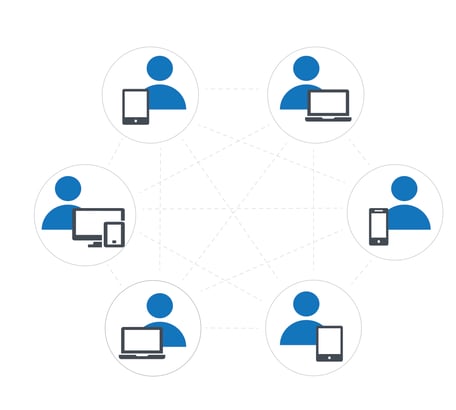The COVID-19 pandemic has accelerated practice management challenges for law firms at a rate no one could have predicted. With employees working more regularly from home, law firms find themselves operating in a new, more distributed way.
Forward-thinking leaders are embracing this challenge and finding opportunities to leverage technologies to maximize firm productivity, deliver quality service and attract and retain the best talent.
The Distributed Firm
In the Distributed Law Firm, employees work from diverse locations some or most of the time. Remote work is no longer a special case - it is the norm.
Managing productivity and communications between remote team members is one of the most significant challenges firms now face.

Successful firms are innovating to meet these challenges by leveraging technology to work smarter and more flexibly.
In this article we explore 5 technology essentials that enable law firms to flourish in the era of distributed work:
| 5 Essentials | |
| 1. IT Best Practices | 4. Virtual Client Service |
| 2. Remote Collaboration | 5. Business Continuity |
| 3. Document Management | |
IT Best Practices
In the Distributed Firm, effective technology is more vital than ever before. Feature capabilities such as collaboration tools and document management systems enhance productivity and ensure accountability. But before the firm can begin benefiting from these, job one is to establish rock-solid back-office IT that provides efficient remote access to the firm’s software and information resources.
With users working from different locations at any time of day, it is essential to ensure client information is protected, back-office systems are always available, and firm members can effectively collaborate to sustain productivity and client service. IT management demands are greater and patchwork solutions end up being expensive. It’s time to work smarter.
Key IT considerations to support distributed work include:
IT Management and Network Infrastructure: The essential requirement to run most legal software is a well maintained Microsoft network including servers such as a file server, active directory, applications servers, backup, firewalls and other security services. This is the IT backbone that requires on-going attention. Getting this right is essential to the operations of the entire firm.
Security: Protecting the firm’s information from dangers like ransomware was already challenging, but distributed work introduces new threats. As some firm members access information from external computers, which may be shared with other family members, the threat of viruses and mal-ware increases significantly. While management tools, if rigorously implemented, will reduce this risk, the safest approach is to use a virtual desktop that almost completely eliminates the risk of the firm’s network being exposed.
IT Helpdesk: Knowledgeable, responsive user support from professionals who understand the firm’s priorities is essential to maintaining productivity. Remote support tools go a long way, but support agents need specialized knowledge of legal software like PCLaw, NetDocuments, Primafact, or Time Matters.
Strategic Planning: As the business landscape changes, it is essential to have a plan that connects the dots between business direction and enabling technologies. Staying on the right path requires understanding technology trends and how they will meet the evolving needs of law firms.
Successfully implementing IT best practices has always been a challenge for firms whose expertise is law rather than technology. Distributed work amplifies this reality. By moving the firm’s network to a state-of-the-art data centre – a Private Cloud, the firm achieves high availability, advanced security and IT best practices to maximize productivity and maintain client service.
Remote Collaboration
With a highly reliable and accessible IT platform in place, a key challenge for effective distributed work becomes remote communication and collaboration.
Before now, teams relied on email for back and forth exchanges, supplemented by in-person conversation. But a linear email inbox with unstructured threads does not provide the ability to monitor and manage messages across many concurrent projects; email simply doesn’t allow for the organic conversation a healthy, productive team needs.
Distributed work using email can greatly impede the quality of team communication, which is why many firms are adopting robust internal communications tools like MS Teams to maximize productivity and to minimize errors.
MS Teams
Microsoft designed Teams to be the “communications hub” that replaces Outlook for internal communication. At its core it allows users to easily conduct multiple, independent conversations simultaneously about client matters and other work.
The “Team” is the core unit of organization and each team can have multiple “Channels” (conversations). Within a Channel it’s possible to have further threads of discussion, to post and collaborate on documents and hold live chats and audio/video calls.
MS Teams makes information management easy and efficient: when new posts are made within a Team, users are notified in an activity feed or by pop-up message. Team and Channel navigation is very straight-forward, enabling users to review the history of a discussion for instant context.
MS Teams also delivers powerful document review capabilities. Users can create or import MS Word, Excel or PowerPoint documents for discussion and real-time collaboration. Two or more people can review and edit a document at the same time, enabling fulsome discussion and review.
Additional capabilities include Zoom-like video meetings, integrated calendars with Outlook, and many installable apps such as MS Planner to enhance capabilities and connect to external systems.
Document Management
In the Distributed Firm, efficient document management is even more critical for overcoming barriers to communication and remotely accessing file systems. From engagement letters to contracts, to submissions, for many firms efficient document creation is key to productivity.
Traditional document management systems (DMSs) save documents into an organized database that allows high-speed searching based on document profiles and the full-text content of the documents themselves. The firm’s knowledgebase is built organically over time, and it overcomes “silo-ing” of knowledge.
In addition to searching, mature DMS products include features such as document versioning, audit trails, sophisticated security settings, support for numerous file formats, and web-based access.
When it comes to document creation and review, integration between the DMS and MS Teams is another key requirement. Tools such as real-time document collaboration for document review are essential for distributed work, but they require transfer of files from the DMS into Teams. Mayhem can ensue if it isn’t clear which copies of documents are current.
The best approach is for the DMS to “check-out” documents to Teams and make them read-only while they are being edited. Once collaborative work is complete, they can be checked-in again to the DMS, where they can be versioned and indexed for efficient retrieval and release. Robust systems such as NetDocuments automate this process to make it as easy as possible for users.
MS Teams is remarkably flexible with how users can access documents: from any device or web browser, it becomes possible to securely access, open and even mark-up documents. Firm members enjoy enhanced mobility that enables them to be productive in any location.
With increased capabilities come new risks as documents are potentially opened on many devices, some outside the firm’s protected network. The firm’s document management system should provide for secure access to the firm’s documents from all of the firm’s work devices.
Virtual Client Service
Virtual client service has become the norm for the Distributed Firm, which means firms must adopt tools and policies to engage clients virtually, and deliver online services.
Videoconferencing
Video meetings are an opportunity for firms to cost-effectively deliver greater value to clients. They provide the human touch, without the overhead of travel. This translates to more satisfied clients and greater productivity.
Meetings can be conducted from anywhere if the lawyer is using a secure firm notebook. A challenge for lawyers using tools like Zoom or GoToMeeting on remote devices is that their documents, saved on the firm’s network, aren’t easily available. One option is to copy documents onto the device, which is a hassle and it can introduce security vulnerabilities. An alternative is to run Zoom inside a virtual desktop, in which the file system and videoconference application are integrated on one secure platform, accessible from any location.
Virtual desktop is the most secure option for law firms using videoconferencing software, however firm users must stay on top of developments and follow best practices to keep client video meetings private.
File sharing
Already inefficient paper based document delivery is even less viable in the Distributed Firm where work is done and transactions are concluded remotely. There are significant efficiency benefits for the firm and clients if documents can be delivered, shared and executed electronically. Unfortunately, it is impractical and insecure to deliver large files by email.
Client Portal software allows for secure sending of documents to a client via a dedicated secure web page. Once the firm publishes a document to the portal, the client receives an email with a link to log in and access the new document. The portal shows the firm when the client has accessed documents, and previous documents remain available until the firm removes them or they expire.
Programs like Citrix ShareFile provide highly secure file sharing and include the ability for the firm to provide a “branded” experience with the firm’s logo displayed. Key features are easy to use and the software includes advanced features for future consideration.
Business Continuity
The Distributed Firm introduces new challenges for protection of client information and practice continuity.
Maintaining Operations
When the COVID-19 pandemic began, and firms were forced to exit their offices during initial phases of social distancing, those with more limited digital capabilities were impacted the most. Firms had varying experiences with on-going operations and those with robust and well maintained back-office systems were best able to continue practising and to meet client needs.
Legacy software such as PCLaw or Time Matters, designed to run on servers and desktop computers inside the office, can be the most challenging to use remotely. Virtual desktop software, properly configured and delivered, provides a superior remote work experience when using these applications.
Information Security
Employees working from remote unmanaged computers creates significant security vulnerabilities and may expose the firm’s network to viruses or malware such as cryptolocker. A fully protected and secure distributed IT platform, such as Private Cloud, solves this problem. With a virtual desktop, it is possible to safely access information without exposing it to external threats. Firm members open their files in the virtual desktop and not on the local computer - no information is saved on the local device and everything stays inside the firm’s protected network.
Another critical element of planning for business continuity is implementing a robust data backup and recovery architecture to ensure files are kept safe, intact and can be recovered quickly in any scenario. Data should be automatically backed up to a secondary site on a regular basis, with scheduled testing and vetting.
For business continuity, data retention and recovery must be planned carefully to ensure the firm can recover quickly and with minimal disruption to the practice. With a Private Cloud and virtual desktop these capabilities are built in and are handled automatically.
Planning Beyond COVID-19
COVID-19 has been a wake-up call for all firms and especially those who have let their technology lag behind. As we return to a “new normal”, improved productivity, client service the desire to attract the best talent will have a lasting impact on work patterns and legal services.
The Distributed Firm is here to stay and the most successful firms will use technology to their lasting advantage.


















